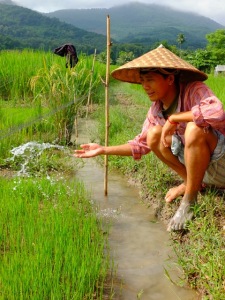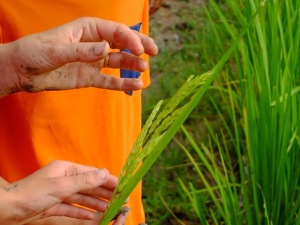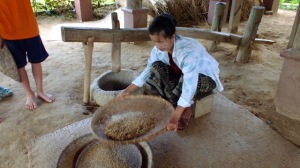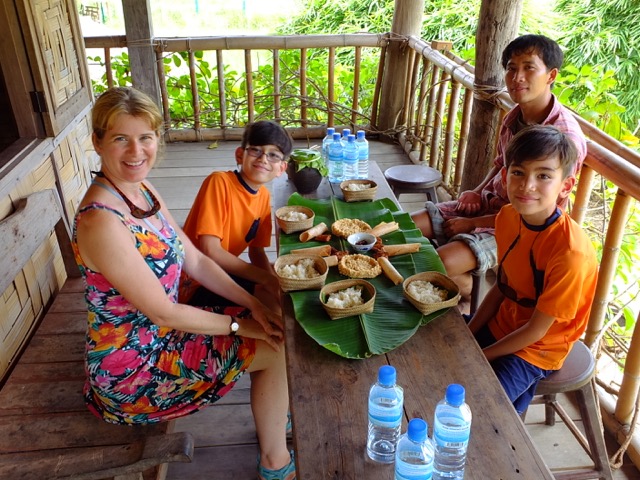Rice is such an important crop in Laos, and you see rice field upon rice field everywhere, so we decided that understanding a little bit more about how rice is grown might also help us to understand more about the Lao people. To help us do this we drove to a field outside of Luang Prabang and met Mr. Laut Lee, the manager of the Living Land Farm, and our guide for the day. He would be the one to walk us through the 14 different stages for making rice – from seed to table.
Laut Lee provided each of us with a traditional farmer hat. These hats are woven from bamboo and protect you from the sunlight, when working in the fields. Connor’s hat was falling off so he traded it for a smaller one. Off we went for stage #1 of growing rice!
The first thing the farmer has to do is pick which seeds are suitable for planting. He fills a big barrel with water and adds a fresh egg to it. The egg will sink to the bottom. He scoops in some salt until the egg rises to the top. He does this so that he knows that the water density is correct for seed separation. Next, he puts in the rice seed (rice which has not been husked). The good seed will sink and the seeds which cannot be used will float to the surface. This happens because the good seeds are dense enough to sink. The bad seeds are not strong enough and would not make a good crop. These ones can be fed to the chickens! He scoops out the good seeds and rinses them with clean water to remove the salt. The seeds need to be used right away.

 In order to plant the seeds, you need a plot of land. You sprinkle the seeds onto the surface and wait 3 or 4 days for the seeds to germinate. This is your rice nursery. Once the seedlings are 10 cm tall or so, they are ready to be transferred to the rice paddy but before you do this, you must complete stage 3: ploughing the field!
In order to plant the seeds, you need a plot of land. You sprinkle the seeds onto the surface and wait 3 or 4 days for the seeds to germinate. This is your rice nursery. Once the seedlings are 10 cm tall or so, they are ready to be transferred to the rice paddy but before you do this, you must complete stage 3: ploughing the field!
 When we ploughed the field we used Rudolph, the water buffalo to pull the plough. Rudolph walks through the muddy, sloppy area and you hold on to the wooden handle of the plough behind him. You must move the plough back and forth so that it turns up the soil/mud. This is much harder than it sounds, since your feet sink deep into the mud and you are practically dragged behind Rudolph while he saunters around smiling at you!
When we ploughed the field we used Rudolph, the water buffalo to pull the plough. Rudolph walks through the muddy, sloppy area and you hold on to the wooden handle of the plough behind him. You must move the plough back and forth so that it turns up the soil/mud. This is much harder than it sounds, since your feet sink deep into the mud and you are practically dragged behind Rudolph while he saunters around smiling at you!
Rudolph is a pink water buffalo (naturally that colour – not painted!). Water buffalo are used for this job because they are very strong, sturdy and very gentle natured. Rudolph was so gentle that we could climb up and sit on him! I’m not sure he was impressed but he didn’t make a fuss and kept the same “whatever” expression on his face the whole time.
Once the field is ploughed you need to plant the seedlings. To do this, you take 2 or 3 seed lings and push them into the mud. The farmers often get together in large groups for planting and they sing songs to help make it fun. I felt like I was sinking in the mud because it was so mushy, since the rice requires a lot of water to grow. There has to be enough water to lie over top of all of the mud and keep it wet. The seedlings should be planted in rows, but we seemed to have a bit of trouble doing that!
lings and push them into the mud. The farmers often get together in large groups for planting and they sing songs to help make it fun. I felt like I was sinking in the mud because it was so mushy, since the rice requires a lot of water to grow. There has to be enough water to lie over top of all of the mud and keep it wet. The seedlings should be planted in rows, but we seemed to have a bit of trouble doing that!
Next, you have to wait while the rice grows. This can take 3 to 4 months. During this time, the farmer has to come and check the water levels of the paddies each day. If there is not enough water, you use your feet to open the irrigation ditches to let more water in. If there is too much water, you take your feet and build a mud dam to block the irrigation ditch. Also, the farmer has to check each of the rice paddies for weeds and pull them out. You also need to put nets on them to keep out the birds. Cats can help to keep the mice away.
 When the rice is fully grown (the plants will be tall and you will see the rice sprouts coming out the top of the plant) you use a tool called a sickle to cut the plants.
When the rice is fully grown (the plants will be tall and you will see the rice sprouts coming out the top of the plant) you use a tool called a sickle to cut the plants.
You leave the bottom of the plant in the mud. (This is the stalk.) You can collect a few stalks together and wrap them with one of the stalks to create a bundle. You then lay them in the sun to dry. This takes 3 or 4 days.
Once the rice is dry you collect the bundles and bring them to an area with a mat and wooden device. You use the wooden device to pick up the rice stalks and you smash the bundle down against a wooden bench to shake out all of the grain.
Once all of the grain is out of the bundles you use a large bamboo fan to fan the grain. This will blow away any dead bits of stalk and any bad rice kernels.
The farmers can use their bamboo hats to scoop up the rice off the mats and put them in large bamboo baskets.
Different tribes of Lao people have different ways of carrying the baskets of rice back to their house. I tried the backpack method, which is two straps attached to a bamboo basket and you put it on your back. It was comfortable because the basket didn’t have hardly any rice in it!
You bring the baskets of rice to your house and need to put handfuls of rice in a mortar and pestle. To make the pestle go up and down you have to step on and off a long piece of wood. The pestle comes down on the rice and cracks open the kernel so that the rice inside comes out. This was not easy to do because the pestle was very heavy and it took a lot of energy to crack just a small amount of rice.
You pull out a few handfuls of rice from the mortar and put it on a large flat bamboo “winnow”. You have to toss the rice on the winnow in such a way that the husks blow off and you are left with just the rice. When we first tossed the bamboo tray you need to be careful that you don’t toss the good rice with the husks.
Once you have just the good rice kernels left you can prepare to cook them. The Lao people like sticky rice and that is the kind that we were about to consume. The rice kernels need to be soaked over night and then rinsed before you cook them. The best way to cook sticky rice is to steam it so that the sugars are released, making it nice and sticky.
This was certainly a meal to remember!
As a little bonus, Laut Lee showed us many of the tools that he and his family used on the farm. He showed us a machine they had made to squeeze the juice out of sugar cane (and we got to drink some!), homemade mouse traps, their blacksmith set up to make their own knives and sickles and our favourite: a cross bow that he used to hunt fish and animals. We went to his pond and fed the fish, then he told us about how he could catch them with his bamboo bow and arrow. We found this quite hard to believe so he went and got it and shot it at a small fish in the water and hit it!! We had to run and get in his boat and paddle out to pick up the fish. Wow! What a way to get your dinner!
Overall, we learned a huge amount at the farm and we all agreed it was one of our favourite experiences so far. Thank you “Living Farm”!































Very interesting details about the production of rice. I want to know if there were leeches in the mud?
LikeLike
I asked that question! They said there ARE leeches but usually in the middle of the rainy season – and we were at the end!
LikeLike
Excellent description of rice growing! I didn’t know the process was so detailed. Do you know if they use any artificial fertilizer or is it organic?
LikeLike
It is all organic! They do use fertilizer but it’s water buffalo poop. Looking forward to seeing you soon in the summer!
LikeLike
What a great experience! Who knew it was such a long and complicated process! You guys rocked the hats!
LikeLike
I especially liked Connor’s hat. It seemed every too had more than one use. There is a faster way on the bigger farms or because labor is so cheap it is still planted the same way????
LikeLike
Some of the wealthier farmers have started using “tractors” and machinery in the fields but many farmers in the mountains still follow the traditional ways.
LikeLike
Your experience at the rice farm must have been awesome. Thank you for sharing your adventure with us.
Jackson and Lincoln
LikeLike
Wow! That was so cool – I imagine you will not look at rice the same ever again 🙂
And Barb you looked very cute is your lovely dress ploughing the field behind Rudolph! – that picture made me smile 🙂
What an incredible experience you guys are having!
LikeLike
Loved the rice growing lesson. I knew parts, but your detailed description with photos pulled it all together for me. You should be a teacher. 😀
Also, I like the water density test by adding salt to the water to make the egg float. We may try that in MS science.
LikeLike